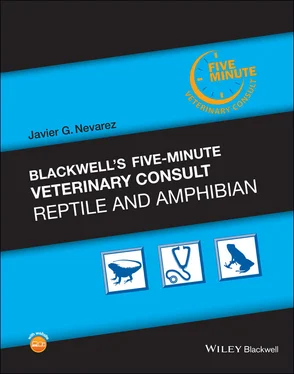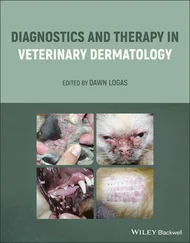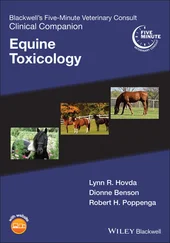Total erythrocyte counts are lower than in mammals and birds.
Erythrocytes in chelonians are larger compared with other reptiles; they tend to have counts below 500,000/μl.
Fecal Occult3 Blood Test and Urinalysis
May allow for the detection of small amounts of blood in an animal’s urine or feces.
Fecal occult test may return false positives in carnivorous species.
Pathologic findings will be specific to the underlying cause of anemia.
 TREATMENT
TREATMENT
APPROPRIATE HEALTH CARE
Anemia is often a chronic presentation in most reptiles.
A slower metabolism and physiologic adaptation mechanisms allow reptiles to compensate better than birds or mammals.
Treatment is often not needed on an emergency basis, but is rather focused on addressing the underlying diseases and providing supportive therapy.
Proper nutrition is key for the prevention and treatment of anemia.
The diet should be as varied as possible and adapted to each species.
Diet should be balanced and contain natural sources of vitamin B12 and iron.
Nutritional support via gavage feeding should be implemented in very ill and/or anorectic animals.
CLIENT EDUCATION/HUSBANDRY RECOMMENDATIONS
It is recommended to perform annual health evaluations of the animals at risk.
These evaluations should include blood tests and fecal exams.
Any treatments must be performed based on the results of the exams and the historical data for the collection.
These tests should also be done on newly acquired and quarantined animals.
A proper nutritional plan is also essential for good health.
 MEDICATIONS
MEDICATIONS
DRUG(S) OF CHOICE
Hemorrhagic anemia: control bleeding by applying pressure. Efficacy of blood replacers or transfusions has not been well studied.
Use of hemostatic agents such as D‐aminocaproic acid or ethamsylate has not been reported in reptiles; doses are empirical (0.1 ml/kg).
Fluid therapy: isotonic fluids should be administered at a rate of 20–30 ml/kg IV, IO, or SC for maintenance.
Fluid losses can be replaced but be careful not to overhydrate the patient.
Colloids may also be used at a rate 10–20 ml/kg with a bolus of 3–5 ml/kg IV or IO as needed.
Blood transfusion: homologous transfusions are preferred over heterologous. Blood volume of up to 1% body weight is extracted from the donor, by means of syringes and needles filled with anticoagulant at a ratio of 1:6 to 1:9 anticoagulant to blood. The blood is administered to the recipient by means of an infusion pump at 5 ml/hour flow rate. True efficacy is not well documented but clinical experience suggests some short‐term benefits.
Maladaptation syndrome: treatment consists of fluid therapy and stimulation of blood regeneration by means of iron dextran (12 mg/kg, IM every 7 days) and cyanocobalamin (vitamin B12; 0.5 mg/kg or 10–2000 iu according to the animal weight as single IM or SC dose).
Availability of blood replacers varies across the world. If available, products like Oxyglobin® (bovine hemoglobin glutamer) 1 ml/100 g IV for 5 minutes by means of perfusion; repeat 4 hours later) may improve success in severe anemia.
Epoietin alfa (EPOGEN®, Amgen Inc., Thousand Oaks, CA) erythropoeisis stimulating agent is reported as safe and effective in Chelonia mydas and Caretta caretta when used at 100 U/kg SC 3 times weekly over 2 weeks. Similar dosing has not been useful in Testudo hermanni.
N/A
 FOLLOW‐UP
FOLLOW‐UP
PATIENT MONITORING
Because of the small size of some chelonians, monitoring should rely on assessment of the behavior and clinical signs of the affected animal, not just on blood sampling.
If the treatment is appropriate, the lizard should become progressively more active and alert, with interest in hunting, seeking shelter or mating behaviors.
Normal attitude and feeding behavior are two common aspects that can be monitored in chelonians after the start of treatment, because they are related to the overall health.
In addition, signs of healing of the other diseases that have contributed to the animal’s anemia should be observed.
EXPECTED COURSE AND PROGNOSIS
Repeated blood samplings after 1 week and 1 month may show early signs of regeneration.
Repeated blood sampling may be contraindicated, especially in cases of non‐regenerative anemia, when working with small patients, or if the underlying etiology is not being treated.
If the underlying cause of anemia is properly diagnosed and can be effectively treated, prognosis is good.
 MISCELLANEOUS
MISCELLANEOUS
COMMENTS
N/A
N/A
Inadaptation syndrome
Maladaptation syndrome
EDTA = ethylenediaminetetraacetic acid
IM = intramuscular
MCH = mean corpuscular hemoglobin
MCHC = mean corpuscular hemoglobin concentration
MCV = mean corpuscular volume
PCV = packed cell volume
SC = subcutaneous
Cital S. Exotic animal blood transfusions: An overview. VetBloom http://blog.vetbloom.com/exotics/exotic‐animal‐blood‐transfusions‐an‐overview
Martínez‐Silvestre A. How I treat anemia in reptiles. Southern European Veterinary Congress Annual Conference, Barcelona, October 19, 2013. www.ivis.org/library/sevc/sevc‐annual‐conference‐barcelona‐2013/how‐i‐treat‐anemia‐reptiles
1 Boyer TH. Autoimmune hemolytic anemia in a parson’s chameleon, Calumna parsonii parsonii. Proc ARAV 2002; 9:81–84.
2 Saggese MD. Clinical approach to the anemic reptile. J Exot Pet Med 2009; 18(2):98–111.
3 Wu C, Chie CHH. Case study: successful treatment of acute anaemia with whole blood transfusion and supportive care in two turtles. Proc UPAV/AAVAC/ARA 2014:13–20.
AuthorAlbert Martínez‐Silvestre, DVM, MSc, PhD, DECZM (Herpetology), EBVS European Veterinary Specialist in Herpetological Medicine and Surgery, Acred. AVEPA (Exotic Animals)
Anorexia
 BASICS
BASICS
DEFINITION/OVERVIEW
Anorexia is the lack of appetite or intake of food, and does not define an underlying cause. Many pathological and even physiological conditions can result in decreased food intake. Anorexia is distinct from decreased appetite, which is also known as hypophagia.
Читать дальше

 TREATMENT
TREATMENT MEDICATIONS
MEDICATIONS FOLLOW‐UP
FOLLOW‐UP MISCELLANEOUS
MISCELLANEOUS BASICS
BASICS










